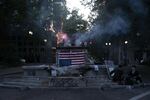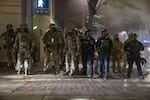In a far ranging presentation Wednesday, Portland Police Bureau Deputy Police Chief Chris Davis attempted to draw a distinction between what he called “legitimate protest” and “criminal activity.”
Related: Federal Law Enforcement Agencies Deployed To Portland Protests
“There’s a very big difference between protests and the kind of mayhem that we’ve seen every night,” Davis said.
At times over the past 40 nights, protests in the city against police violence and systemic racism have drawn upwards of 10,000 people, Davis said in his presentation on how the demonstrations have affected the city. Marches have often culminated at the Multnomah County Justice Center. In recent weeks, hundreds of people from across the city have continued to show up to the Justice Center nightly to protest nonviolently.
Those demonstrations have routinely ended in violence after Portland Police respond to thrown objects with impact munitions and tear gas to disperse the mostly nonviolent crowd.
In the presentation, Davis said protesters have thrown frozen water bottles and rocks at police, at times causing injuries. He declined to provide details on those injuries, citing privacy for officers.

Hundreds of protesters gathered at the Justice Center on the 4th of July to protest systemic racism and police violence. Protesters cooked, danced, burned American flags and set off fireworks before Portland Police and federal law enforcement used tear gas and impact munitions to disperse the crowd.
Jonathan Levinson / OPB
In total, Davis said more than 100 city employees and members of the public have been injured during the protests, which, according to PPB, have resulted in $23 million in damages and lost business in the city. Davis didn’t provide details on either figure. Police have faced criticisms for injuring members of the public by using less lethal munitions during demonstrations.
Davis also took questions on the federal law enforcement officers who have had a larger presence during protests in recent days.
Related: Portland Police Under Scrutiny For Dangerous Crowd Control Munitions
On July 4, a large contingent of federal officers cleared Portland streets alongside PPB. Federal officers from the Federal Protective Service, the U.S. Marshals Special Operations Group, and Customs and Border Patrol’s Border Patrol Tactical Unit, the agency’s SWAT equivalent, all participated.
Their presence and broad jurisdiction complicates PPB’s job.
Though local and federal officers walked side-by-side to disperse protesters, Davis said they were operating independently under two completely separate chains of command.
“We’re in charge of our assets and they’re in charge of theirs,” Davis said, describing an unusual and potentially dangerous arrangement for a tactical operation. “It’s probably less than ideal.”
Their presence also creates two sets of laws governing the protesters, media and legal observers. Portland Police and, according to a federal judge, "all persons acting under the direction of the Portland Police Bureau" are subject to two temporary restraining orders. The first limits law enforcement's use of less lethal munitions and tear gas. The second order restricts their interactions with media and legal observers.
If federal officers are operating alongside, but independent from Portland Police, then it’s possible those restraining orders don’t apply to them.
“I don’t have authority over federal officers,” Davis said. “They’re governed by their own policies and procedures. They’re acting under federal law, federal authority. ... It does complicate things for us.”

Federal law enforcement officers, along with PPB, dispersed hundreds of protesters from the Justice Center and federal courthouse on the 4th of July during protests against systemic racism and police violence. Protesters ate food, danced, burned American flags and set off fireworks before Portland Police and federal law enforcement used tear gas and impact munitions to disperse the crowd.
Jonathan Levinson / OPB
Davis said they try to mitigate potential issues by having a federal representative in the PPB command center during protests.
Overall, Davis painted a dark picture of the protesters showing up every night to the Justice Center to protest racism, police violence and to demand the police be defunded. In the presentation, he portrayed the presence of umbrellas, respirators and makeshift shields in the crowd as evidence that the protesters are highly organized. The police also played videos of protesters staying together in the face of police dispersal efforts.
“Just watch how people are trying to regroup this group of people so they can get them back focused on that common objective,” Davis explained. “This group is not restricted from leaving this area at all. They can walk away.”
He said the past six weeks have been unprecedented in Portland's history and that it isn't sustainable.
Asked how PPB plans to resolve the standoff, Davis said he’d like to see a clear message from the community whether these protests are consistent with their values.
